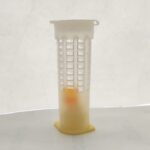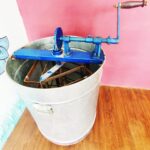Beekeeping Equipment
EQUIPMENT
- Bee Brush – Bee brushes have long, soft, non-ridged bristles that are gentle enough to move bees off delicate comb while being firm enough to remove bees from old frames, equipment, or the beekeeper.
- Bee Veil – When working with bees, beekeepers wear a fine fabric or wire mesh hat around their heads.
- Uncapping Knife – A knife with a broad, double-edged blade attached by an offset to a wooden handle: used to cut off the covers or caps of the honeycomb before extracting the honey.
- Grafting Needle – These grafting needles have a spring-loaded plunger that gently pushes the larva out of the reed and into the cup, allowing you to precisely transfer an individual bee larva to a queen cell cup.
- Honey Scrapper – Best for uncapping sunken areas of honeycomb that cannot be decapper with a cutter.
- Queen Cage – allows the queen to start laying eggs in a safe and controlled environment before being released into her new colony
- Queen Rearing Frame – A smoker is the most useful tool for beekeepers. Bees are calmed and stinging is reduced when someone smokes.
- Honey Wooden Dipper – Used to collect Honey from a container.
- Hive Tool – Used to open the hive, loosen hive parts, lift frames, scrape up propolis and excess wax; it can even remove the venom sac from the skin following a bee sting.
- Gloves – Gloves are mainly used to avoid being stung as a sting on a hand will cause swelling, reducing hands mobility and usage of fine molar skills.
- Hive Tool – Ideally shaped for prying apart supers and frames.
- Honey Extractor – Instrument used for separation of honey, from honeycomb.

Bee Brush – Bee brushes have long, soft, non-ridged bristles that are gentle enough to move bees off delicate comb while being firm enough to remove bees from old frames, equipment, or the beekeeper.

Bee Veil – When working with bees, beekeepers wear a fine fabric or wire mesh hat around their heads.

Grafting Needle – These grafting needles have a spring-loaded plunger that gently pushes the larva out of the reed and into the cup, allowing you to precisely transfer an individual bee larva to a queen cell cup.

Gloves – Gloves are mainly used to avoid being stung as a sting on a hand will cause swelling, reducing hands mobility and usage of fine molar skills.

Hive Tool – Used to open the hive, loosen hive parts, lift frames, scrape up propolis and excess wax; it can even remove the venom sac from the skin following a bee sting.

Queen Cage – Allows the queen to start laying eggs in a safe and controlled environment before being released into her new colony.

Uncapping Knife – A knife with a broad, double-edged blade attached by an offset to a wooden handle: used to cut off the covers or caps of the honeycomb before extracting the honey.







